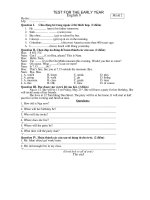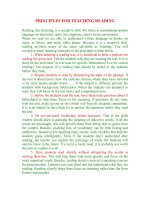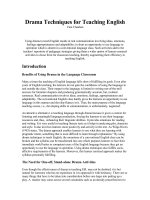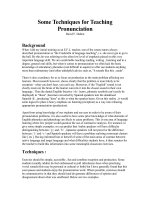Strategies for teaching early chinese language learners
Bạn đang xem bản rút gọn của tài liệu. Xem và tải ngay bản đầy đủ của tài liệu tại đây (792.89 KB, 47 trang )
Strategies for Teaching
Early Chinese Language
Learners
Shuhan C. Wang ( 王周淑涵 ), Ph.D.
Asia Society
Carol Ann Dahlberg ( 杜凯若安 ), Ph.D.
Concordia College, Moorhead, Minnesota
Overview
Essential Elements of Curriculum
Special Considerations for Teaching
Chinese in K-6
•
Oral Language and Literacy
•
Ten Principles
Lessons from Experience
Working with 飞向中文 :
Kindergarten-6
Standards-based
Content-related
Thematically Designed
Language learning system
Essential Elements for
Building Curriculum
飞
飞
向
向
中文
中文 is guided by…
Standards for
Standards for
Foreign Language Learning
Foreign Language Learning
in the
in the
21st Century
21st Century
Connections
Connections
Comparisons
Comparisons
Communities
Communities
Cultures
Cultures
Communication
Communication
Standards provide:
Realistic goals and benchmarks
Balanced curriculum content
Focus on performance and
assessment
Thematic Planning
Essential Elements:
Essential Elements:
飞
飞
向
向
中文
中文 is guided by…
makes instruction more
understandable to learners
because the theme creates
a meaningful context.
Thematic Planning
provides a rich context for
standards-based learning
Thematic Planning
is student-centered. It involves
students in real language use, in
a variety of situations, modes,
and text types.
Thematic Planning
links language instruction to
the philosophy and content of
the general elementary school
curriculum.
Thematic Planning
connects content, language
and culture goals to a “big idea,”
or enduring understanding, as
recommended by Understanding
by Design
Thematic Planning
Story Form
Essential Elements:
Essential Elements:
飞
飞
向
向
中文
中文 is guided by…
Entering the magical
world of stories
The qualities of a good story
are the qualities of a good
• activity
• lesson
• unit
• plan
Appeals to emotions
Personally meaningful
Sparks the imagination
Satisfying conclusion
Clear BEGINNING
MIDDLE
and END
Each book is a story…
Each lesson is a story…
Each page is a story…
Each activity is a story…
Understanding by Design
Essential Elements:
Essential Elements:
飞
飞
向
向
中文
中文 is guided by…
Stages in the Backward Design Process
Identify
desired
results
Determine
acceptable
evidence
Plan learning
experiences
and instruction
Enduring Understandings
Essential Questions
Performance
Assessments
Teacher Guide
“I can” statements
Identify
desired
results
Backward Design Process
Enduring Understanding:
“Students will understand that:”
Essential Question:
In student language; focuses
student effort and thinking
1









